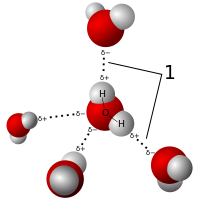
Photo from wikipedia
The electrospinning of highly concentrated solutions of cyclodextrin (CD) leads to bead-free nanofibers without the need of a polymeric carrier. The occurrence of numerous hydrogen bonds among CD molecules is… Click to show full abstract
The electrospinning of highly concentrated solutions of cyclodextrin (CD) leads to bead-free nanofibers without the need of a polymeric carrier. The occurrence of numerous hydrogen bonds among CD molecules is the main driving force for their electrospinning, and hence, additives with hydrogen-bonding potential can disturb the aggregation of CD molecules and affect their electrospinning. In this study, we systematically investigated the influence of five different hydrogen-bonding additives, i.e., methylamine (MA), ethylenediamine (ED), urea, 2,2,2-trifluoroethanol (TFE), and 1,1,1,3,3,3-hexafluoroisopropanol (HFIP), on the solution behavior of hydroxypropyl-β-CD (HP-β-CD) by rheology, conductivity, and NMR analyses, and the morphology of the electrospun HP-β-CD nanofibers by scanning electron microscopy. The 1H NMR chemical shifts of the HP-β-CD protons in D2O were observed with the incorporation of hydrogen-bonding molecules due to the occurrence of intermolecular associations between HP-β-CD and additives. Dynamic light scattering measurements revealed a clear decrease in the aggregate size with the introduction of additives. Unlike other additives, which showed a general decreasing trend in viscosity with increasing additive content, the addition of MA led to a significant increase in the viscosity with increasing concentration and gave rise to HP-β-CD nanofibers at lower concentrations. The addition of low concentrations of ED, urea, TFE, and HFIP led to thinner nanofibers due to the lower viscosity of the respective solutions. Increasing additive content deteriorated the electrospinnability of HP-β-CD solutions, resulting in beaded fibers. A systematic relationship was found between the solution viscosity and morphology of the respective electrospun fibers. Overall, this study, for the first time, reports the influence of hydrogen bonding on the polymer-free electrospinning of CD molecules and shows a correlation between solution properties and morphology of their electrospun nanofibers.
Journal Title: ACS Omega
Year Published: 2018
Link to full text (if available)
Share on Social Media: Sign Up to like & get
recommendations!